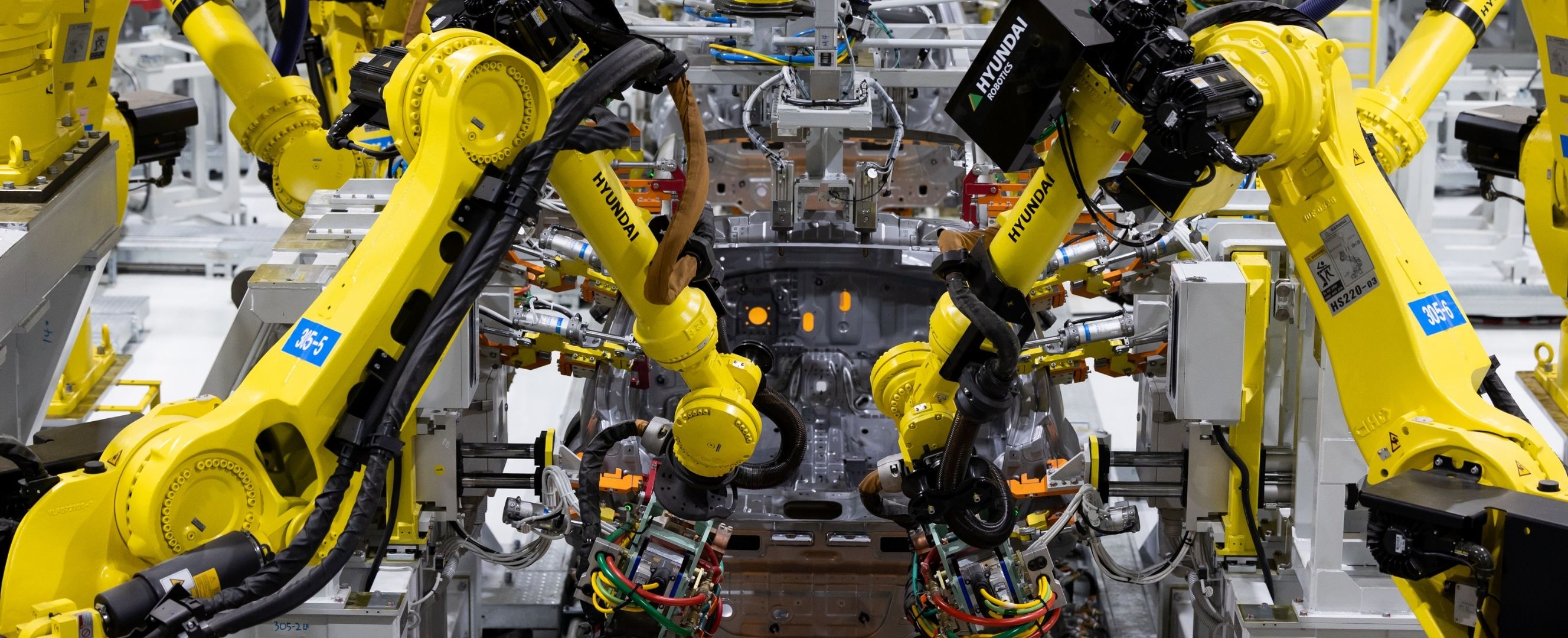Advances in technology affect trade and vice versa
Technological change is exciting and scary, empowering us to do more with less work while fueling fears of being replaced. Although it drives economic growth and progress, those who fall behind risk losing their livelihoods.
International trade has a similar impact but generates even greater anxiety. That’s because its benefits are less obvious to people than the gains from innovation, and the domestic workers dealt setbacks by trade associate their losses directly with gains for foreign workers.
When technological change and international trade combine, the impact can be especially potent. The combination accelerates innovation, technology adoption, and economic growth. However, it can also become a polarizing force, both within and between countries.
Geopolitics tends to further intensify emotions. As countries jostle for position on the technological frontier, trade emerges as a vital conduit for the transfer of these game-changing innovations. International commerce accelerates global growth as technology spreads, but it also carries the risk of sharing trade secrets with foreign adversaries.
All these pressures influence policy choices. The effects on workers from trade and technology have historically led to calls for protection, though strengthening the social safety net and helping workers find new jobs are a better long-term strategy than trade barriers. International security threats are being met with calls for industrial policies and export controls, though these may backfire if they distort domestic resource allocation while stimulating investment in strategic products abroad.
In a world that is fragmenting and where technological diffusion is slowing, governments face new policy challenges to stimulate trade, innovation, and growth. Though innovators may aim to “move fast and break things,” policymakers still must protect existing institutions and maintain predictability for investors.
Technology, trade, and development
Technological advances can give rise to new goods, such as electric vehicles; new processes like automation and 3D printing; and new modes of transportation, such as containerization and instant data transmission over the internet. All affect trade and tend to promote development.
The emergence of new goods, such as smartphones and flat-screen TVs, allows innovating countries to displace producers of obsolete goods, in this case flip phones and bulky cathode-ray tube TVs. Overall trade tends to increase as the new goods spur greater demand.
The adoption of new processes can increase production efficiency, which in turn reduces real prices and drives a surge in production and exports from the innovating countries. A concern for developing economies, which tend to specialize in simple stages of production that may be automated, is that demand for their exports will fall. However, research suggests that the scale effects of automation typically result in a greater need for imported parts, even if some of them eventually are domestically produced. In automobile production, for instance, robotization in advanced economies has coincided with an increase in imported parts and components from low-income countries.
Like technological advances in transportation, telecommunications innovation has also played a crucial role in facilitating trade. The internet, for example, enables businesses to find new suppliers and partners located far away. It has also opened up new areas of trade, particularly in digital services.
Trade also influences technological change by creating a larger market with more intense competition. Frontier firms with access to the global market can expand their profits and invest in research and development, leading to more rapid innovation. At the same time, competition from other global leaders gives firms an incentive to remain at the forefront of technological advancement.
The overall effect of trade and technology on development is positive, because new technologies improve productivity and expand trade. Trade also enables new technologies to spread more rapidly around the world, further promoting growth.
However, there are winners and losers from both technological advancement and trade, with those locked into outdated technologies falling behind. As a result, some countries may see certain industries decline, requiring support for workers who lose jobs as technology and trade continue to spread. Similarly, countries that are largely excluded from global markets, because of politics, geography, or infrastructure, will lag further behind the global frontier.
The political response
Historically, trade barriers have often been used to protect industries that are losing competitiveness to foreign counterparts. For instance, in the 1970s and 1980s, technological advancement in Japan led to cheaper and better cars and semiconductors, which prompted the US to manage trade by restricting imports and promoting exports. Intellectual property protection has also been sought primarily by rich countries to protect their companies’ proprietary technologies and profits, rather than to protect national security.
However, in recent years, export controls on scarce materials used in high-tech products, the machines to make them, and even the high-tech goods themselves have become a powerful tool designed to slow technological advancement in foreign countries. These government interventions depress global growth and innovation by design, as trade and the transmission of technology slow down. Reduced exports of high-tech products also mean slower profit growth and less money for high-tech industries to invest in research and development.
New trade restrictions can, moreover, be particularly detrimental to environmental goods and green innovation. The shift to renewables will be quicker if innovation is global and prices fall rapidly. Greater access at lower prices to products such as solar panels and batteries will mean less coal, gas, and oil will be burned.
The way forward
Solving the problem of people left behind because of trade and advances in technology requires a stronger social safety net. Although redistribution policies have often been insufficient to combat the changes that come with economic transformation, there is a clear policy prescription: governments can continue to promote trade and technology and can use the proceeds to support the people and places negatively affected by the changes. Unemployment insurance and retraining programs are critical to keeping trade open and free.
The more complex question going forward is how to leverage trade and technology to address the existential threats we face today, without risking domestic security. From surviving pandemics and natural disasters to adapting to and slowing climate change, innovation to find solutions and international trade and cooperation to share those solutions are arguably the most important tools in mitigation. But they carry security risks.
Consider how trade and technology have shaped recent experiences: COVID vaccines were developed and released worldwide (albeit unevenly) in record time, benefiting from global partnerships in research and production. Semiconductors, the foundation of all electronic devices and machines, are designed largely in the US and produced mostly in Asia. Electric vehicle batteries can’t be produced without cobalt, lithium, and nickel—minerals sourced primarily from Africa and South America.
Unfortunately, geopolitics is shaping the creation and spread of new technologies, with serious consequences for development and climate action. The United States has tariffs on most imports from China and regulates a growing share of exports; China has responded in kind. These tariffs are slowing growth in the two largest global economic engines and hurting global innovation.
The danger of overreach is real, with serious consequences for trade and growth. Rather than taking a broad-brush approach, growth and innovation would benefit from government protection only of products threatened by technology, along with continued expansion and deeper integration with trusted partners.
There is also a danger that policies will backfire. For example, export controls on advanced chips and the tools to produce them could cause the US to lose its formidable edge in design as a result of smaller market share and shifting incentives abroad. If that happens, the policy may ultimately lead to bigger security risks.
The question other countries need to ask is what to do to avoid being caught in the middle of US-China conflict. Fortunately, despite the security risks, most tenets of standard economics still hold. Countries that encourage business entry and expansion with a good investment climate, sound infrastructure, and access to finance will remain at the forefront of innovation. Open trade and predictable policies will continue to push resources into their most productive uses. As some production relocates away from China, countries that adhere to such policies stand to benefit.
All countries must avoid being lured by the false attraction of widespread state intervention. China’s remarkable economic growth over the past 30 years was driven by reforms that stimulated private industry, and growth is now slowing. The private sector in China has been underestimated for many decades, but now the public sector’s ability to steer growth is being overestimated. Rather than protectionism and industrial policies, maintaining predictability, a rules-based system, trade openness, and access to capital are what will keep countries headed in the right direction.
Perhaps the biggest danger of the current trend toward protectionism and industrial policy is that such practices are highly contagious. History has shown repeatedly that tariffs lead to retaliation, breeding ever more tariffs. Similarly, government support for a particular firm or an industry puts foreign competitors at a disadvantage, leading them to lobby for similar support. A world where protectionism and subsidies spiral out of control would be a huge step backward on the path to raising global incomes and solving pressing challenges.
Opinions expressed in articles and other materials are those of the authors; they do not necessarily reflect IMF policy.









